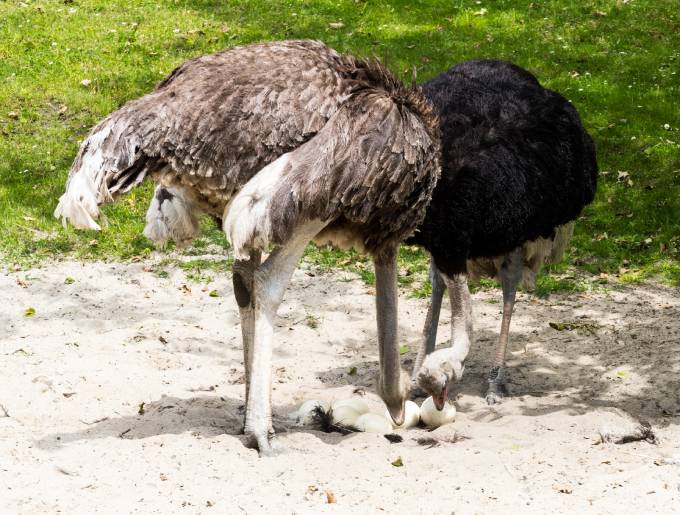The ostrich is perhaps one of the most famous of all 60 flightless birds on the planet. These large birds average 7 feet tall, but some have been known to be 9ft high!
They are the biggest, tallest, and heaviest birds in the world. Yet, we often associate an ostrich with the saying ‘bury one’s head in the sand.
Ostriches bury heads in the sand
It is difficult to say where the well-known idiom originated that ostriches bury heads in the sand when they first sense danger.
The truth is they don’t. Ostriches have little reason to. Not only would they be unable to breathe, if they bury their heads, but they would also have no awareness of what predators are doing.
The American Ostrich Association has hypothesized that the saying results from the ostrich’s tendency to lie low at the first sign of danger.
The ostrich doesn’t just run away!
The ostrich is a fearsome bird. It weighs roughly 350 pounds and will generally avoid predators using powerful legs.
They are known to reach a top speed of 69kph and can maintain a steady pace of 45kmph for 20-30 minutes! This makes them one of the fastest animals on the planet.
But predators should be wary when dealing with ostriches. They kick forwards but with enough power to kill a human and, in some cases, a lion.
There is certainly no reason for heads in the sand!
Why this species became flightless birds
It is believed that birds didn’t have many predators in the past. This led to a ground-based existence.
Over time this resulted in the wings no longer lifting the bird off the ground, making them flightless.
Of course, they grew larger and more powerful to compensate.
Ostriches and the baby bird
Female ostriches dig holes in the ground when they are ready to have baby ostriches.
They don’t build traditional nests; instead, they create holes in the ground measuring up to 8ft wide and 3ft deep! They then bury the eggs in the hole, and the male and female birds take turns sitting on them and keeping them warm.

A few times daily, they bury their heads to check the egg and use their beaks to turn the eggs gently.
Protecting their eggs
Ostriches have been known to drop flat to the sand. This is when they feel they cannot outrun or fight off a predator. Fortunately for ostriches, this is a rare occurrence.
Interestingly, they can effectively blend into the sand, becoming almost invisible.
However, if predators threaten their eggs, they are more likely to run. They will likely outrun the danger and draw it away from the nest.
Other interesting ostrich facts
Ostriches are unique creatures, with small heads, light-colored neck blends, and surprisingly powerful legs. They may not be able to fly, but they still have a few tricks up their sleeves:
- They have three stomachs!
- Their wings span 7ft and provide shade for their chicks and perform an essential part of their mating ritual.
- They use their wings to change direction when running at speed
- They often live in pairs except during the breeding season
- The eggs take up to 45 days to hatch, and they raise the chick together
- The wild ostrich population has declined dramatically between hunting for meat and feathers. Most ostriches are in farms or game parks
- Both ostriches and emus rely on a surge of lymphatic fluid to achieve erect penises. This is completely different from the blood vascular method used by mammals and reptiles.
Final thoughts
The ostrich is a strange and fascinating bird that doesn’t really bury its head in the sand.
Of course, the saying is still valid, as no one should bury their head in the sand. Think about that and the wonder of the ostrich next time someone tells you to take your head out of the sand!


